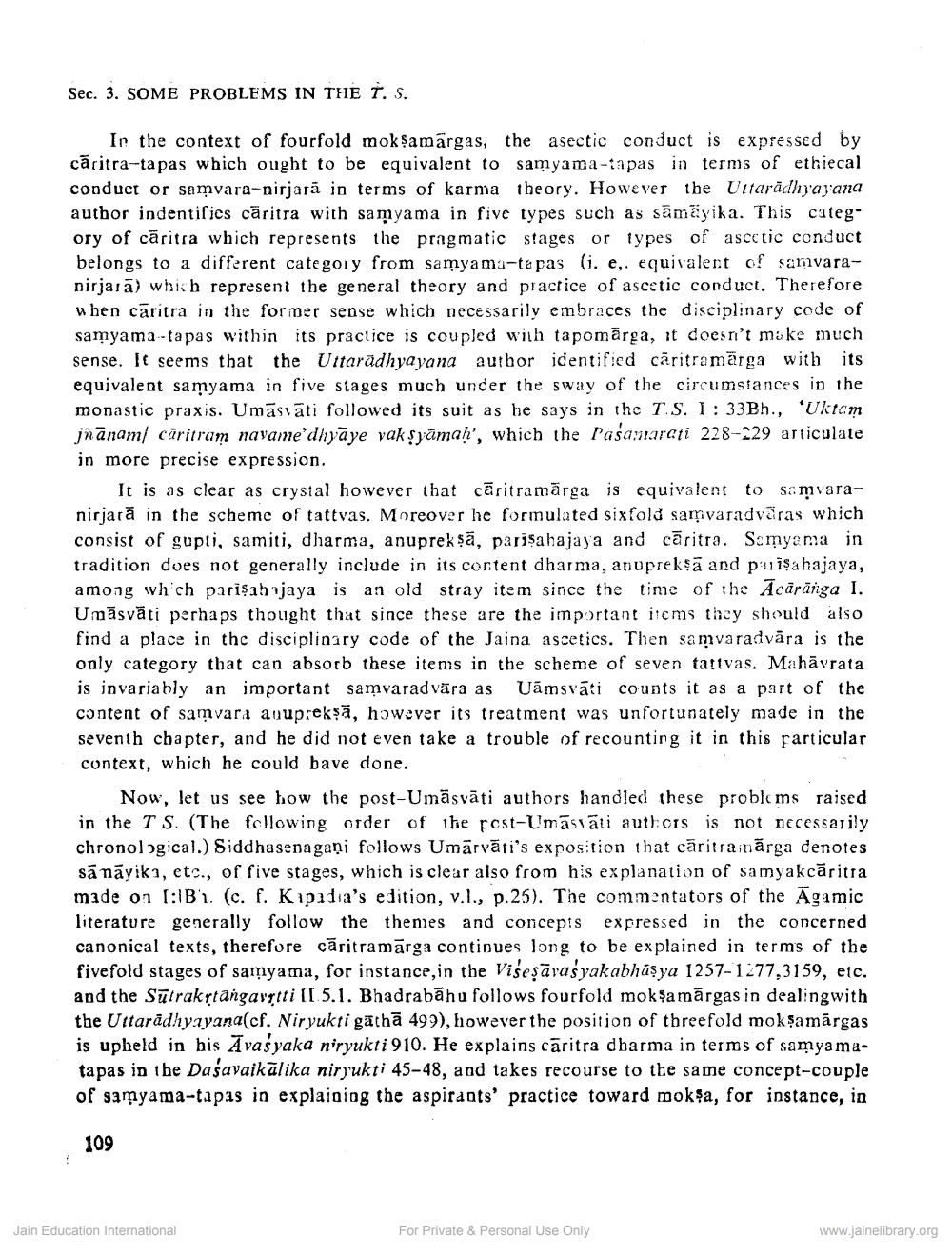________________
Sec. 3. SOME PROBLEMS IN THE T. S.
In the context of fourfold mokşamārgas, the asectic conduct is expressed by cāritra-tapas which ought to be equivalent to samyama-tapas in terms of ethiecal conduct or samvara-nirjară in terms of karma theory. However the Uttarādhyajana author indentifics cāritra with samyama in five types such as sāmāyika. This category of caritra which represents the pragmatic stages or types of ascctic conduct belongs to a different category from samyama-tapas (i. e, equivalent of samvarapirjaia) which represent the general theory and practice of ascetic conduct. Therefore when caritra in the former sense which necessarily embraces the disciplinary code of samyama--tapas within its practice is coupled with tapomārga, it doesn't make much sense. It seems that the Uttaradhyayana author identified caritramärga with its equivalent samyama in five stages much under the sway of the circumstances in the monastic praxis. Umās āti followed its suit as he says in the T.S. 1:33Bh., 'Uktom jñānam/ caritram navame'dhyāye vak ş yāmah', which the Pasamarati 228-229 articulate in more precise expression.
It is as clear as crystal however that caritramārga is equivalent to samvaranirjară in the scheme of tattvas. Moreover he formulated sixfold samvaradvāras which consist of gupti, samiti, dharma, anupreksā, parisa hajaya and cāritra. Samyama in tradition does not generally include in its content dharma, anupreksā and pyişa hajaya, among which parişah ajaya is an old stray item since the time of the Acârānga I. Umāsvāti perhaps thought that since these are the important items they should also find a place in the disciplinary code of the Jaina ascetics. Then samvaradvāra is the only category that can absorb these items in the scheme of seven tattvas. Mahāvrata is invariably an important samvaradvāra as Vāmsvāti counts it as a part of the content of samvara ajupreksā, however its treatment was unfortunately made in the seventh chapter, and he did not even take a trouble of recounting it in this particular context, which he could bave done.
Now, let us see how the post-Umāsvāti authors handled these problems raised in the TS. (The following order of the post-Umāsvāli authors is not necessarily chronological.) Siddhasenagani follows Umārvāti's exposition that caritra mārga denotes sānāyika, etc., of five stages, which is clear also from his explanation of samyakcăritra made on I:1B'. (c. f. Kapıda's edition, v.l., p.25). The commentators of the Agamic literature generally follow the themes and concepts expressed in the concerned canonical texts, therefore cāritramārga continues long to be explained in terms of the fivefold stages of samyama, for instance, in the Viseşārasyakabháşya 1257-1277,3159, etc. and the Sūtrakrtangarriti [ 5.1. Bhadrabāhu follows fourfold mokşamārgas in dealingwith the Uttarādhyayana(cf. Niryukti gathā 499), however the position of threefold mokşamārgas is upheld in his Āvas yaka niryukti 910. He explains cāritra dharma in terms of samyamatapas in the Daśavaikālika niryukti 45-48, and takes recourse to the same concept-couple of samyama-tapas in explaining the aspirants' practice toward mokļa, for instance, in
109
Jain Education International
For Private & Personal Use Only
www.jainelibrary.org




